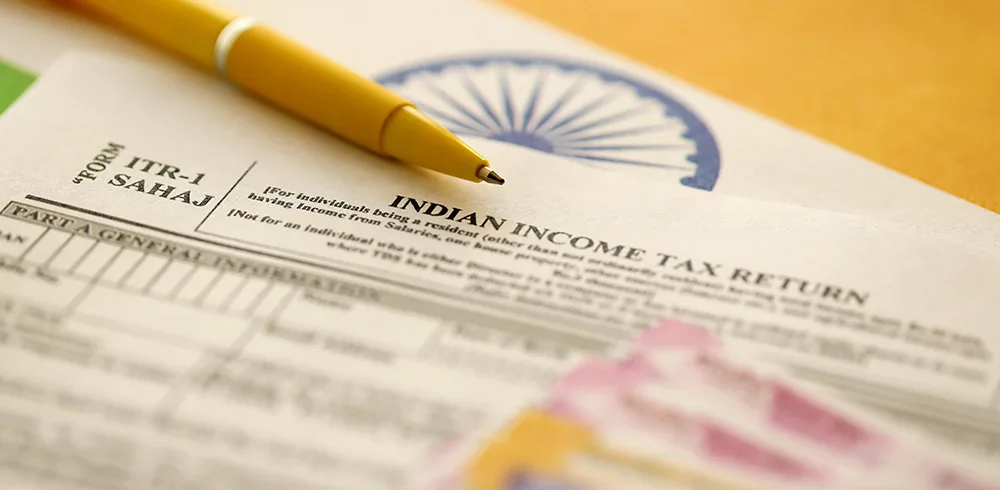Income Tax Returns (ITR) are official documents that are filed with the government to report an individual’s or entity’s earnings, deductions, and taxes paid during a financial year. They help ensure compliance with tax laws, enable possible refunds of overpaid taxes, and are also a legal proof of income for various financial transactions. Filing ITR is now simpler than ever. Here’s a guide on how to file returns online so that you are better prepared to file ITR online.
Documents Needed to File ITR
Here are all the relevant documents that will make your e-filing process smoother:
- PAN Card and Aadhaar Card
- Form 16: If you are a salaried individual, this form is provided by your employer and summarises your salary, tax deductions, and other details.
- Form 16A or Other TDS Certificates: If TDS (Tax Deducted at Source) is deducted on other incomes like interest, commission, or rent, you will need Form 16A (or relevant TDS certificates).
- Bank Statements: Keep your bank statements handy to check for any other income such as interest, dividends, etc.
- Investment and Expense Proofs: Documents supporting deductions under various sections (like Section 80C for investments in ELSS, PPF, etc., or health insurance premiums under Section 80D).
- Capital Gains Statements (if applicable): For those who have sold property or made stock market transactions, having detailed statements of gains or losses is vital.
Steps on How to File Income Tax Returns Online
ITR is used by taxpayers to formally declare their income, deductions claimed, exemptions and taxes paid. Here’s a step-by-step guide on how to do it carefully.
Step 1: Visit the official Income Tax e-filing website and create an account using your PAN as the user ID. If you already have an account, enter your PAN or Aadhar. Click on ‘Continue’.
Step 2: You will get a Secure Access Message. Verify your user ID. Enter password for your e-Filing account.
Step 3: Click on the e-File > Income Tax Returns > File Income Tax Return.
Step 4: On Income Tax Return Page:
- Select ‘Assessment Year’
- Select Online in Select Mode of Filing
- Click on Start Filing
- Select Type of assesee and click on ‘Continue’
- Click on “Start New Filing.”
- Select from “Individuals/HUF/Others.”
- Select ‘ITR Form’.
- Click on proceed
- Click on “Let’s get Started.”
- Select the applicable option from “Are you filing Income Tax Return for any of the following reasons?”
- Click on Continue button
Step 5: Read the Instructions carefully and Fill all the applicable and mandatory fields of the online ITR Form.
Step 6: After confirmation of all tabs, click on ‘Proceed’.
Step 7: Click on ‘Preview return’ check out the first checkbox and click on ‘Proceed to preview’.
Step 8: Download the ITR form and take a printout for your reference.
Step 9: Click on ‘Proceed to validation’. The error list will be displayed, resolve the error so get zero error and click on ‘Proceed to verification’.
Step 10: E-Verify your ITR.
There are several convenient methods to e-verify your return. You can choose to receive an OTP on your Aadhaar-linked mobile number, use a Digital Signature Certificate (DSC), generate an Electronic Verification Code (EVC) via net banking, bank account, or Demat account, or use an existing EVC or Aadhaar OTP if you already have one.
Common Mistakes to Avoid
Here are some common mistakes to avoid while filing income tax returns:
- 1. Using the Wrong ITR Form: This can lead to your return being classified as defective.
- 2. Not Reporting All Income: Interest from savings accounts or side gigs often gets overlooked.
- 3. Mismatch in Personal Details: Ensure your name, PAN, and Aadhaar details match exactly.
- 4. Failing to E-Verify: An unverified return is treated as invalid.
- 5. Missing the Deadline: Late filing can attract penalties and loss of certain benefits.
While the e-filing portal is designed to be user-friendly, first-time filers might still have questions about tax deductions or complex income structures. If you are unsure about anything, consult a Chartered Accountant (CA) or a certified tax professional.








